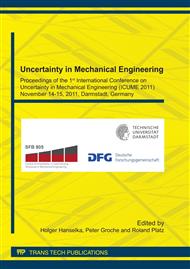p.67
p.75
p.83
p.95
p.103
p.115
p.125
p.133
p.145
Methods for the Control of Uncertainty in Multilevel Process Chains Using the Example of Drilling/Reaming
Abstract:
Uncertainty during production processes has an important influence on the product quality as well as production costs. For multilevel process chains with serially connected processes, additional uncertainty can be caused by the previous step. The manufacturing of precision holes by drilling and reaming is an important multilevel process chain. The interactions between machine, tool and pre-drilled hole cause process errors during the quality determinant final reaming process. In this paper, a systematic approach for the identification and control of uncertainty during the reaming process is presented. Thus, the influence of key aspects like skewness of pre-drilled hole or the influences of material strength gradients are analyzed. Further, simulation models for the consideration of these uncertainties are presented.
Info:
Periodical:
Pages:
103-113
Citation:
Online since:
September 2011
Authors:
Keywords:
Price:
Сopyright:
© 2012 Trans Tech Publications Ltd. All Rights Reserved
Share:
Citation:


